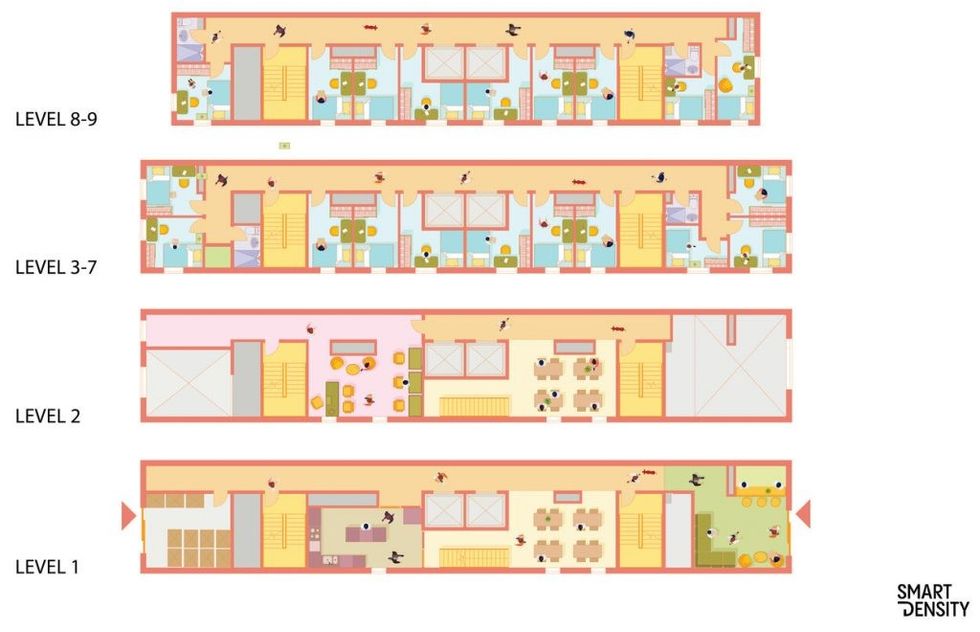Housing affordability is a crisis that plagues major cities around the world. It is a complex issue that will take time to resolve, but one housing model quickly gaining momentum could be part of the solution if we let it: co-living.
What Exactly is Co-Living?
The co-living movement revives a centuries old concept where people -- unrelated to one another -- live together and share common spaces. More specifically, the co-living advocacy organization, Co-Liv, defines co-living as “more than two unrelated people living together voluntarily in a home-as-service residence that has a communal focus and is life-enhancing.”
While co-living is sometimes dismissed as ‘dorms for adults,’ it can actually be much more. Co-living is not just about living in a small space and using communal areas. At its core is a sense of community and belonging. Co-living also appeals to many different people, from seniors to students to young professionals looking for social interaction and more affordable housing options.
The Canadian Context for Co-Living
Large cities in the United States and Europe such as New York, Los Angeles, London or Berlin are seeing an increase in the number of co-living providers. This includes websites that connect individuals who want to co-live with suitable spaces and roommates as well as companies that own and operate entire buildings designed for co-living lifestyles.
Co-living has been slower to come to Canada. Bungalow, one of the websites that connects people to co-living opportunities, is still only available in US cities. The website, CoLiving.com, is another place to search for roommates and co-living options, but only has a handful of listings in Toronto and Montreal and none in Vancouver.

However, some developers are starting to explore and create dedicated co-living inspired facilities in Canada. Node, a co-living provider with buildings in cities like Brooklyn, Dublin, and Los Angeles will soon open a 50-unit building in Kitchener that caters to young professionals. The rooms will be fully furnished and will include a small kitchen and living room, plus access to communal lounges and resident events.
Common, another co-living provider, is planning a co-living facility in Ottawa. The building, known as Common Zibi, will be part of the new 15-hectare Zibi community and will offer a mix of co-living and traditional suites. The co-living suites will cost up to 30% less than the market rate for a 1-bedroom unit in the area. There will be shared bathrooms, kitchens and lounges, as well as other amenities and socializing opportunities.
The Toronto Context for Co-Living
One of the major reasons why co-living has been slow to come to Toronto specifically is because it's technically illegal in many parts of Toronto.
Co-living falls under the City’s definition of multi-tenant housing, which is when four or more people rent rooms and share a kitchen and/or washroom (also commonly referred to as “rooming houses”). Such housing setups are subject to specific regulations which can make the establishment of co-living housing tricky.
For one, multi-tenant housing is only allowed in certain parts of the city, with different areas having their own unique sets of restrictions. Some areas require City-issued permits to operate multi-tenant houses, while others don’t. In other areas, multi-tenant houses are only allowed in buildings that were originally constructed as detached or semi-detached houses. Different areas also have different limits on the number of units allowed in a house, ranging from 6 to 25. The list of area-specific restrictions goes on.
READ: Toronto 2051: Will We Have Flying Cars Before We Figure Out Housing?
Overall, these complex and inconsistent rules can make co-living confusing and hard to execute across Toronto. Luckily, the City is currently reviewing their multi-tenant housing policy. If approved, there will a more consistent zoning policy for the entire city, plus additional measures to promote health and safety in multi-tenant houses. The drafted policy still partially limits the type of building that multi-tenant housing is permitted in, but only in certain residential zones. In mixed-use zones, purpose-built co-living facilities could be allowed, but would still be capped at 25 units. Either way, this new policy could open the door for more co-living facilities -- closer to what is being offered in Kitchener and Ottawa -- throughout Toronto.
The Benefits of Co-Living
Toronto could see numerous benefits if co-living became more widespread and easier to establish. Some of the most frequently cited benefits include socialization and affordability.
According to some studies, up to 1 in every 5 Canadians is lonely and this figure is especially high among Canadian seniors. Co-living improves social interactions by incorporating it into daily life. Co-living can provide a sense of belonging and community, which can be beneficial to one's mental health.
The affordability stems from how it reimagines new housing models and presents new options to the market. By dismissing the status quo where each unit must have its own kitchen, living room, and washroom, space can be used more efficiently. This efficiency also brings up another very important but less discussed benefit of co-living: increased density.
Instead of 20 people each needing their own kitchen that maybe gets used once a day, 20 people can share a few large kitchens while still having all their essential needs covered. This model not only improves housing affordability, it also allows more people to live in areas that are well served by transit and close to existing amenities and services.
Co-living is not a new concept, but one that is being updated to meet the needs and desires of today’s society. It may be a departure from convention, but it may also be a glimpse towards a future that is more sustainable, a future where people are happier, more socially connected, and don’t have to spend more than half their paycheque on a roof over their head.
And If that’s not what convention provides, then maybe it’s time we throw convention out the door.





















